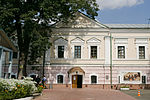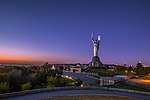Pecherskyi District
Pages with non-numeric formatnum argumentsPecherskyi DistrictUrban districts of Kyiv

Pecherskyi District (Ukrainian: Печерський район, romanized: Pecherskyi raion) is an urban district of Kyiv, the capital of Ukraine. It lies within the eponymous historical neighborhood, while also including some other historical areas. The Pechersk (Ukrainian: Печерськ, Pechers'k) neighborhood is located on the hills adjoining the right bank of the Dnieper. These two geographical entities are often confused with each other. The Pecherskyi District can be considered to be the very heart of Ukraine.
Excerpt from the Wikipedia article Pecherskyi District (License: CC BY-SA 3.0, Authors, Images).Pecherskyi District
Mykoly Mikhnovskoho Boulevard, Kyiv Zvirynets
Geographical coordinates (GPS) Address Nearby Places Show on map
Geographical coordinates (GPS)
| Latitude | Longitude |
|---|---|
| N 50.420555555556 ° | E 30.549444444444 ° |
Address
Mykoly Mikhnovskoho Boulevard 38
01014 Kyiv, Zvirynets
Ukraine
Open on Google Maps










